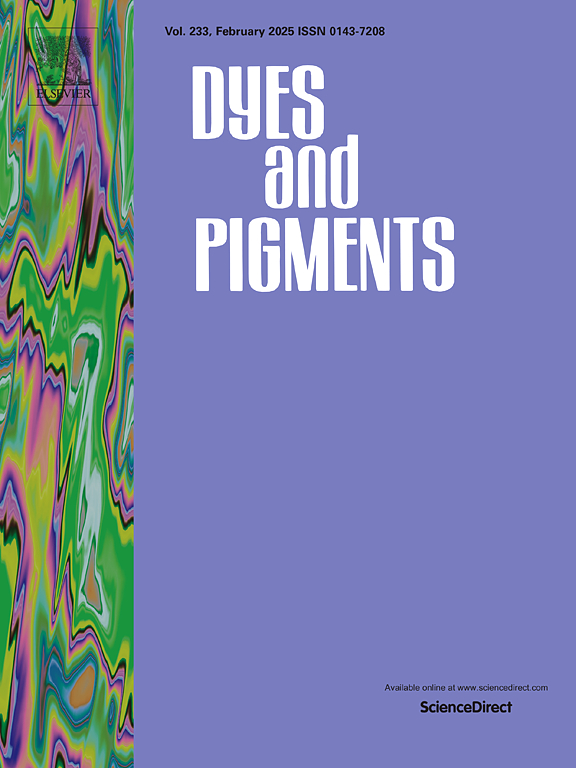基于二甲基二氢芘-偶氮苯杂化体系的多态二阶非线性光开关
IF 4.2
3区 工程技术
Q2 CHEMISTRY, APPLIED
引用次数: 0
摘要
本研究开创性地应用量子化学方法系统地阐明了双光致二甲基二氢芘(DHP)-偶氮苯(AB)杂化体系衍生的多态分子开关在异构化过程中的二阶非线性光学(NLO)响应的演化。通过时间依赖的密度泛函理论(TDDFT)模拟,我们揭示了复杂的结构-性能相关性,并建立了NLO性能分子水平控制的理论框架。结果表明,在该混合系统中,波长选择性光激发和热处理可诱导级联异构化途径(E-C↔Z-C↔Z-O→E-O↔E-C),表现出有效的“ ON-OFF-OFF-ON-ON ” NLO切换行为。E-C结构衍生物在乙腈中表现出最大的动态βHRS值(8.4 × 104 a.u.),比传统的DO3体系高出5.7倍,这是由于增强的分子内电荷转移(ICT)和扩展的π共轭作用。我们发现,供体- dhp /受体- ab连接(系列1化合物)产生最佳的NLO性能,βHRS值比反向配置高32 - 243%,为高性能NLO材料的设计提供了可行的策略。DHP-AB混合系统成为具有无损读出能力的多电平光存储器件的有前途的NLO开关候选器件。我们的发现为可调谐NLO开关提供了分子设计蓝图,使先进光电技术的发展成为可能。本文章由计算机程序翻译,如有差异,请以英文原文为准。

Multistate second-order nonlinear optical switches based on dimethyldihydropyrene-azobenzene hybrid system
This study pioneers the application of quantum chemical methods to systematically elucidate the evolution of second-order nonlinear optical (NLO) responses in multistate molecular switches derived from a dual photochromic dimethyldihydropyrene (DHP)-azobenzene (AB) hybrid system during isomerization processes. Through time-dependent density functional theory (TDDFT) simulations, we unravel the intricate structure-property correlations and establish a theoretical framework for molecular-level control of NLO performance. The results reveal that, in this hybrid system, a cascade isomerization pathway (E-C ↔ Z-C ↔ Z-O → E-O ↔ E-C) can be induced by wavelength-selective photoexcitation and thermal treatment, exhibiting efficient “ON–OFF–OFF–ON–ON” NLO switching behavior. The derivatives featuring the E-C structure exhibit the largest dynamic βHRS value (8.4 × 104 a.u.) in acetonitrile, surpassing that of the conventional DO3 system by a factor of 5.7, attributed to enhanced intramolecular charge transfer (ICT) and extended π-conjugation. We find that the donor-DHP/acceptor-AB linkage (Series 1 compounds) yields optimal NLO performance, with βHRS values 32–243 % higher than those of the reversed configuration, offering a viable design strategy for high-performance NLO materials. The DHP-AB hybrid system emerges as a promising NLO switch candidate for multilevel optical memory devices with non-destructive readout capabilities. Our findings provide a molecular design blueprint for tunable NLO switches, enabling development of advanced optoelectronic technologies.
求助全文
通过发布文献求助,成功后即可免费获取论文全文。
去求助
来源期刊

Dyes and Pigments
工程技术-材料科学:纺织
CiteScore
8.20
自引率
13.30%
发文量
933
审稿时长
33 days
期刊介绍:
Dyes and Pigments covers the scientific and technical aspects of the chemistry and physics of dyes, pigments and their intermediates. Emphasis is placed on the properties of the colouring matters themselves rather than on their applications or the system in which they may be applied.
Thus the journal accepts research and review papers on the synthesis of dyes, pigments and intermediates, their physical or chemical properties, e.g. spectroscopic, surface, solution or solid state characteristics, the physical aspects of their preparation, e.g. precipitation, nucleation and growth, crystal formation, liquid crystalline characteristics, their photochemical, ecological or biological properties and the relationship between colour and chemical constitution. However, papers are considered which deal with the more fundamental aspects of colourant application and of the interactions of colourants with substrates or media.
The journal will interest a wide variety of workers in a range of disciplines whose work involves dyes, pigments and their intermediates, and provides a platform for investigators with common interests but diverse fields of activity such as cosmetics, reprographics, dye and pigment synthesis, medical research, polymers, etc.
 求助内容:
求助内容: 应助结果提醒方式:
应助结果提醒方式:


